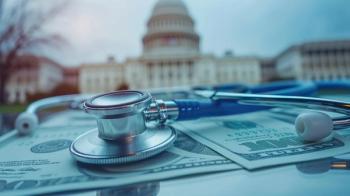
Steroid-Eluting Implants May Reduce Health Care Utilization From Chronic Rhinosinusitis
Lower health care utilization was shown in patients with chronic rhinosinusitis, with and without nasal polyps, who had steroid-eluting implants vs those who did not in the 18 months following endoscopic sinus surgery.
Steroid-eluting implants may reduce the need for health care utilization among patients with chronic rhinosinusitis (CRS), with and without
As an alternative therapeutic option for patients with CRS refractory to medical treatment, sinus surgery has been noted to be technically challenging because of outcomes that can be compromised by several factors. However, recent clinical trials have indicated that steroid-eluting sinus implants improve postoperative outcomes by delivering localized, sustained release of corticosteroids directly onto inflamed sinus tissue.
“While some clinicians have raised concerns regarding the cost of the steroid-eluting sinus implants, analyses have demonstrated that up-front costs associated with the use of the implants are offset by the downstream savings associated with fewer postoperative interventions,” noted researchers. “The direct costs of CRS-related health care are estimated to range from $7 to $13 billion per year.”
Seeking to further assess the impact of steroid-eluting sinus implants on health care utilization among patients with CRS undergoing sinus surgery, they conducted a retrospective, observational study using real-world evidence data from the OM1 Real-World Data Cloud.
The analysis included adult patients with CRS, with or without nasal polyps, who underwent endoscopic sinus surgery between 2014 and 2019 and had at least 18 months of data both before and after surgery. Those who received the implants (n = 1983) were matched with patients who did not receive implants (n = 1983) based on a propensity score developed using baseline characteristics.
“Chi-square for binary variables and analysis of variance tests for continuous variables were applied to compare health care resource use measures,” they explained.
In the 18-month follow-up period, significantly lower incidence of health care visits were reported among patients of the implant vs nonimplant groups:
- All-cause outpatient visits: 94.3% vs 96.6% (P < .001)
- All-cause otolaryngologist visits: 47.3% vs 59.6% (P < .001)
- Alll-cause emergency department/urgent care visits: 9.2% vs 11.8% (P = .007)
- Sinus-related endoscopies: 39.1% vs 43.8% (P = .003)
Although not statistically significant, fewer patients in the implant cohort had undergone repeat surgeries (4.6% vs 5.3%; P = .273), with a 14.1% relative reduction in the implant cohort. Surgeries in the maxillary sinus were associated with the highest overall revision rate in both cohorts (3.1% vs 4.4%), followed by the sphenoid sinus (2.0% vs 1.6%).
“Use of implants had no significant effect on sinus procedures such as debridement and polypectomy, as well as sinus-related imaging such as CT, MRI, and x-ray,” said the study authors. “These findings support the contention that reductions in health care resource use may be achieved using steroid-eluting implants during sinus surgery.”
Reference
Hoffman V, Mortimer KM, Mulder K, Topuriaa L, Gliklicha R, Kallman JE. Real-world evidence analysis of the impact of steroid-eluting implants on healthcare resource use among chronic rhinosinusitis patients undergoing sinus surgery. Curr Med Res Opin. Published online January 20, 2022. doi:10.1080/03007995.2021.2022874
Newsletter
Stay ahead of policy, cost, and value—subscribe to AJMC for expert insights at the intersection of clinical care and health economics.





























































